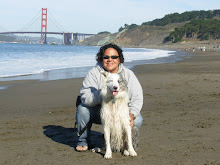Tips for Running with your Dog | January 19, 2009
If you’re struggling to stick to your New Year Resolution to exercise everyday, look no further than your dog for motivation. Chances are he’s ready for a run even when you’re not. That’s because many dogs were bred for running and hard work. Some types, like working and sporting breeds, have enormous amounts of energy and even crave a good vigorous workout.
But before promoting your dog to designated exercise partner, it’s best to consider his qualifications for the job. Sure, running offers huge health benefits and can curb behavioral problems at home, but some dogs are better suited for running than others. Consider the breed, age, size and body type of your dog.
If you know you’ve got a dog that needs more action than the leisurely walk to the park, here are tips to consider before you lace and leash up.
Size Up the Pup. Consider your dog’s overall physical condition before embarking on an exercise plan with him. If he’s older or overweight, the stress of running may be too much pressure on his joints. Have your vet assess his health before deciding how far your dog can run and whether he should at all.
Get a Plan. Just like you, your dog needs to build up his endurance and strength over time to prevent injury and burn out. Start out slowly and watch him for signs of fatigue and overheating. Dogs lose a lot of heat through their mouths so keep an eye out for excessive panting. Become aware of signs of distress and pay attention to body language.
Pad Patrol. Since your dog doesn’t wear cushy sneakers, choose grass and dirt trails that are easy on his paws and check his pads periodically for cuts or injury. Concrete, asphalt and other hard surfaces can hurt your dog's paws and also impact his ability to dissipate heat through his paws. Also consider dog booties depending on your typical running surface.
Water Often. Bring along a collapsible water bowl and bottle so you and your dog can stay hydrated at frequent breaks on the run. They need more water than we do, so consider more breaks than you would otherwise.
Keep it Safe. Be conscious of the weather – not too cold, nor hot or humid. Use a leash to help prevent accidents and keep control, and make sure your dog has appropriate reflective gear if you plan to run at night.
The Scoop:
Additional tips for running safely with your dog
www.goodhealth.com/running
More about dogs’ attitudes toward exercise
www.petcentric.com/exercise
If you’re not a runner, check out these dog running services
www.runnersworld.com/dogs
Subscribe to:
Post Comments (Atom)





No comments:
Post a Comment